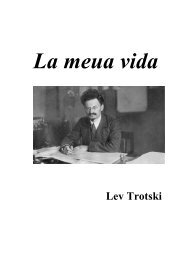in so far as both possess the same quality <strong>of</strong> being human labour, do tailoring and weaving formthe substance <strong>of</strong> the values <strong>of</strong> the same articles.Coats and linen, however, are not merely values, but values <strong>of</strong> definite magnitude, andaccording to our assumption, the coat is worth twice as much as the ten yards <strong>of</strong> linen. Whencethis difference in their values? It is owing to the fact that the linen contains only half as muchlabour as the coat, and consequently, that in the production <strong>of</strong> the latter, labour power must havebeen expended during twice the time necessary for the production <strong>of</strong> the former.While, therefore, with reference to use value, the labour contained in a commodity counts onlyqualitatively, with reference to value it counts only quantitatively, and must first be reduced tohuman labour pure and simple. In the former case, it is a question <strong>of</strong> How and What, in the latter<strong>of</strong> How much? How long a time? Since the magnitude <strong>of</strong> the value <strong>of</strong> a commodity representsonly the quantity <strong>of</strong> labour embodied in it, it follows that all commodities, when taken in certainproportions, must be equal in value.If the productive power <strong>of</strong> all the different sorts <strong>of</strong> useful labour required for the production <strong>of</strong> acoat remains unchanged, the sum <strong>of</strong> the values <strong>of</strong> the coats produced increases with theirnumber. If one coat represents x days’ labour, two coats represent 2x days’ labour, and so on.But assume that the duration <strong>of</strong> the labour necessary for the production <strong>of</strong> a coat becomesdoubled or halved. In the first case one coat is worth as much as two coats were before; in thesecond case, two coats are only worth as much as one was before, although in both cases onecoat renders the same service as before, and the useful labour embodied in it remains <strong>of</strong> thesame quality. But the quantity <strong>of</strong> labour spent on its production has altered.An increase in the quantity <strong>of</strong> use values is an increase <strong>of</strong> material wealth. With two coats twomen can be clothed, with one coat only one man. Nevertheless, an increased quantity <strong>of</strong> materialwealth may correspond to a simultaneous fall in the magnitude <strong>of</strong> its value. This antagonisticmovement has its origin in the tw<strong>of</strong>old character <strong>of</strong> labour. Productive power has reference, <strong>of</strong>course, only to labour <strong>of</strong> some useful concrete form, the efficacy <strong>of</strong> any special productiveactivity during a given time being dependent on its productiveness. Useful labour becomes,therefore, a more or less abundant source <strong>of</strong> products, in proportion to the rise or fall <strong>of</strong> itsproductiveness. On the other hand, no change in this productiveness affects the labourrepresented by value. Since productive power is an attribute <strong>of</strong> the concrete useful forms <strong>of</strong>labour, <strong>of</strong> course it can no longer have any bearing on that labour, so soon as we makeabstraction from those concrete useful forms. However then productive power may vary, thesame labour, exercised during equal periods <strong>of</strong> time, always yields equal amounts <strong>of</strong> value. Butit will yield, during equal periods <strong>of</strong> time, different quantities <strong>of</strong> values in use; more, if theproductive power rise, fewer, if it fall. The same change in productive power, which increasesthe fruitfulness <strong>of</strong> labour, and, in consequence, the quantity <strong>of</strong> use values produced by thatlabour, will diminish the total value <strong>of</strong> this increased quantity <strong>of</strong> use values, provided suchchange shorten the total labour time necessary for their production; and vice versâ.On the one hand all labour is, speaking physiologically, an expenditure <strong>of</strong> human labour power,and in its character <strong>of</strong> identical abstract human labour, it creates and forms the value <strong>of</strong>commodities. On the other hand, all labour is the expenditure <strong>of</strong> human labour power in aspecial form and with a definite aim, and in this, its character <strong>of</strong> concrete useful labour, itproduces use values.§3 The Form <strong>of</strong> ValueCommodities come into the world in the shape <strong>of</strong> use values, articles, or goods, such as iron,linen, corn, &c. This is their plain, homely, bodily form. They are, however, commodities, onlybecause they are something tw<strong>of</strong>old, both objects <strong>of</strong> utility, and, at the same time, depositories<strong>of</strong> value. They manifest themselves therefore as commodities, or have the form <strong>of</strong> commodities,only in so far as they have two forms, a physical or natural form, and a value form.The reality <strong>of</strong> the value <strong>of</strong> commodities differs in this respect from Dame Quickly, that we don’tknow “where to have it.” The value <strong>of</strong> commodities is the very opposite <strong>of</strong> the coarsemateriality <strong>of</strong> their substance, not an atom <strong>of</strong> matter enters into its composition. Turn andexamine a single commodity, by itself, as we will, yet in so far as it remains an object <strong>of</strong> value,it seems impossible to grasp it. If, however, we bear in mind that the value <strong>of</strong> commodities has apurely social reality, and that they acquire this reality only in so far as they are expressions or
embodiments <strong>of</strong> one identical social substance, viz., human labour, it follows as a matter <strong>of</strong>course, that value can only manifest itself in the social relation <strong>of</strong> commodity to commodity. Infact we started from exchange value, or the exchange relation <strong>of</strong> commodities, in order to get atthe value that lies hidden behind it. We must now return to this form under which value firstappeared to us.Every one knows, if he knows nothing else, that commodities have a value form common tothem all, and presenting a marked contrast with the varied bodily forms <strong>of</strong> their use values. Imean their money form. Here, however, a task is set us, the performance <strong>of</strong> which has never yeteven been attempted by bourgeois economy, the task <strong>of</strong> tracing the genesis <strong>of</strong> this money form,<strong>of</strong> developing the expression <strong>of</strong> value implied in the value relation <strong>of</strong> commodities, from itssimplest, almost imperceptible outline, to the dazzling money-form. By doing this we shall, atthe same time, solve the riddle presented by money.The simplest value-relation is evidently that <strong>of</strong> one commodity to some one other commodity <strong>of</strong>a different kind. Hence the relation between the values <strong>of</strong> two commodities supplies us with thesimplest expression <strong>of</strong> the value <strong>of</strong> a single commodity.A. Elementary or Accidental Form Of Value1. The two poles <strong>of</strong> the expression <strong>of</strong> value. Relative form and Equivalent form2. The Relative Form <strong>of</strong> value3. The Equivalent form <strong>of</strong> value4. The Elementary Form <strong>of</strong> value considered as a wholeB. Total or Expanded Form <strong>of</strong> value1. The Expanded Relative form <strong>of</strong> value2. The particular Equivalent form3. Defects <strong>of</strong> the Total or Expanded form <strong>of</strong> valueC. The General Form <strong>of</strong> Value1. The altered character <strong>of</strong> the form <strong>of</strong> value2. The Interdependent Development <strong>of</strong> the Relative Form <strong>of</strong> Value, and <strong>of</strong> theEquivalent Form3. Transition from the General form <strong>of</strong> value to the Money formD. The Money-Form§4 The Fetishism <strong>of</strong> Commodities and the Secret there<strong>of</strong>A commodity appears, at first sight, a very trivial thing, and easily understood. Its analysisshows that it is, in reality, a very queer thing, abounding in metaphysical subtleties andtheological niceties. So far as it is a value in use, there is nothing mysterious about it, whetherwe consider it from the point <strong>of</strong> view that by its properties it is capable <strong>of</strong> satisfying humanwants, or from the point that those properties are the product <strong>of</strong> human labour. It is as clear asnoon-day, that man, by his industry, changes the forms <strong>of</strong> the materials furnished by Nature, insuch a way as to make them useful to him. The form <strong>of</strong> wood, for instance, is altered, by makinga table out <strong>of</strong> it. Yet, for all that, the table continues to be that common, every-day thing, wood.But, so soon as it steps forth as a commodity, it is changed into something transcendent. It notonly stands with its feet on the ground, but, in relation to all other commodities, it stands on itshead, and evolves out <strong>of</strong> its wooden brain grotesque ideas, far more wonderful than “tableturning”ever was.The mystical character <strong>of</strong> commodities does not originate, therefore, in their use value. Just aslittle does it proceed from the nature <strong>of</strong> the determining factors <strong>of</strong> value. For, in the first place,however varied the useful kinds <strong>of</strong> labour, or productive activities, may be, it is a physiologicalfact, that they are functions <strong>of</strong> the human organism, and that each such function, whatever maybe its nature or form, is essentially the expenditure <strong>of</strong> human brain, nerves, muscles, &c.Secondly, with regard to that which forms the ground-work for the quantitative determination <strong>of</strong>value, namely, the duration <strong>of</strong> that expenditure, or the quantity <strong>of</strong> labour, it is quite clear thatthere is a palpable difference between its quantity and quality. In all states <strong>of</strong> society, the labourtime that it costs to produce the means <strong>of</strong> subsistence, must necessarily be an object <strong>of</strong> interest
- Page 4:
égime, which has been through its
- Page 7:
sins of all state forms. That this
- Page 13 and 14:
It has not occurred to any one of t
- Page 15 and 16:
gradually accumulated small capital
- Page 17 and 18:
from this nonsensical ‘prehistory
- Page 19 and 20:
property: the nucleus, the first fo
- Page 21 and 22:
which produces in all nations simul
- Page 23 and 24:
[8. The Inconsistency of the Ideali
- Page 25 and 26:
The ‘essence’ of the fish is it
- Page 27 and 28:
hence of the relationships which ma
- Page 29 and 30:
labour. In the first case, therefor
- Page 31 and 32:
production and commerce soon calls
- Page 33 and 34:
period begins with the Navigation L
- Page 35 and 36:
more advanced countries, still have
- Page 37 and 38:
over against the individuals, so th
- Page 39 and 40:
eality is only a product of the pre
- Page 41 and 42:
never became more than a city; its
- Page 43 and 44:
Only at this stage does self-activi
- Page 45 and 46:
Modern industry has established the
- Page 47 and 48:
these crises, there breaks out an e
- Page 49 and 50:
Further, as we have already seen, e
- Page 51 and 52:
abolish that; the development of in
- Page 53 and 54:
For the rest, nothing is more ridic
- Page 55 and 56:
III. Socialist and Communist Litera
- Page 57 and 58:
conscious of having overcome “Fre
- Page 59 and 60:
The undeveloped state of the class
- Page 61 and 62:
The Paris CommuneAddress to the Int
- Page 63 and 64:
priests were sent back to the reces
- Page 65 and 66:
pregnant. In the full consciousness
- Page 67 and 68:
subjected Versailles and the rest o
- Page 69 and 70: The Eighteenth Brumaire of Louis Bo
- Page 71 and 72: For the rest, every fair observer,
- Page 73 and 74: that here “bourgeois republic”
- Page 75 and 76: Eternalization of historic relation
- Page 77 and 78: and becomes a direct object and ser
- Page 79 and 80: each supplies the other with its ob
- Page 81 and 82: generally. The question evidently b
- Page 83 and 84: is thus the only reality, the movem
- Page 85 and 86: smudge over all historical differen
- Page 87 and 88: elations. Thus e.g. the relation of
- Page 89 and 90: a rise of wages, because every reac
- Page 91 and 92: equally spent upon all articles of
- Page 93 and 94: Apart from some years of failing ha
- Page 95 and 96: enable a currency to adapt itself t
- Page 97 and 98: Smith and his French predecessors h
- Page 99 and 100: conditions of production, with a gi
- Page 101 and 102: in a commodity constitutes its valu
- Page 103 and 104: y working which the working man wou
- Page 105 and 106: just seen that the surplus value co
- Page 107 and 108: increased value of his labour, like
- Page 109 and 110: altogether, is sure to have his wag
- Page 111 and 112: theory, which consists in putting a
- Page 113 and 114: Preface to A Contribution to the Cr
- Page 115 and 116: Capital, Volume I (1867)From the Pr
- Page 117 and 118: A use value, or useful article, the
- Page 119: imposed necessity, without which th
- Page 123 and 124: abstract. The twofold social charac
- Page 125 and 126: ased on the production of commoditi
- Page 127 and 128: Capital Vol. III. Chapter 2. The Ra
- Page 129 and 130: specific relationship to surplus-va


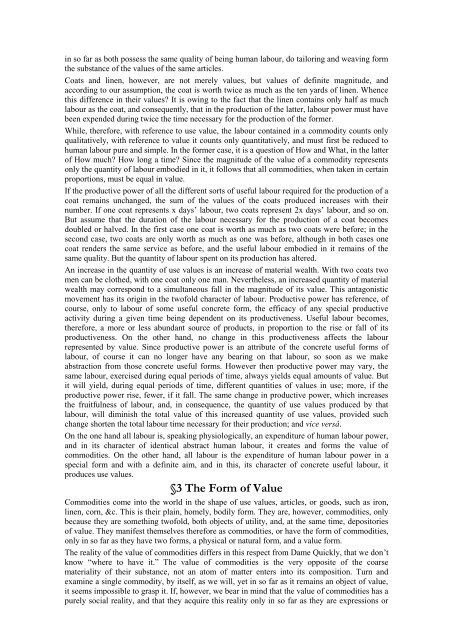
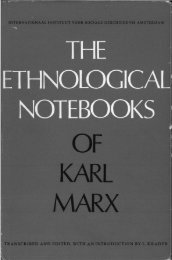

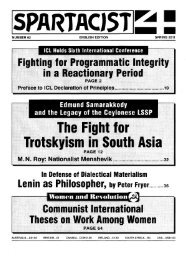

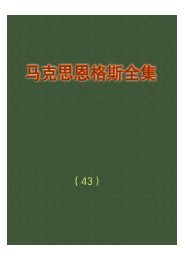
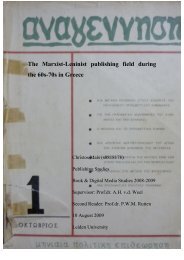
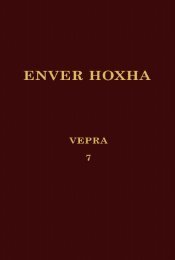
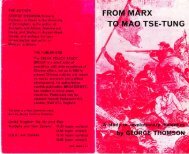

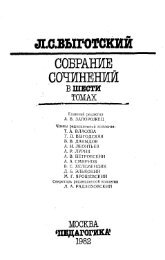
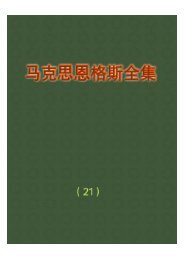
![tyf Enf=O=n]lgg](https://img.yumpu.com/47584932/1/190x245/tyf-enfonlgg.jpg?quality=85)
